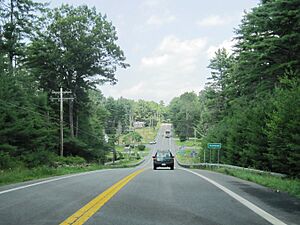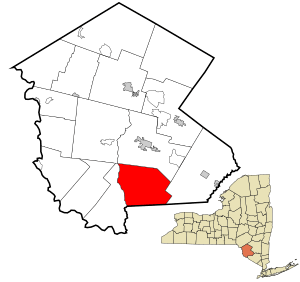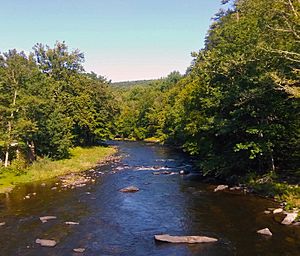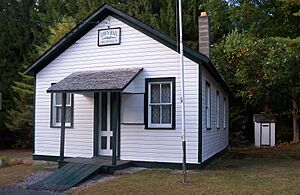Forestburgh, New York facts for kids
Quick facts for kids
Forestburgh, New York
|
|
|---|---|

Hamlet of Forestburgh within the town
|
|

Location of Forestburgh in Sullivan County, New York
|
|
| Country | United States |
| State | New York |
| County | Sullivan |
| Area | |
| • Total | 56.31 sq mi (145.85 km2) |
| • Land | 54.78 sq mi (141.88 km2) |
| • Water | 1.53 sq mi (3.97 km2) |
| Elevation | 1,417 ft (432 m) |
| Population
(2020)
|
|
| • Total | 808 |
| • Density | 14.349/sq mi (5.540/km2) |
| Time zone | UTC-5 (Eastern (EST)) |
| • Summer (DST) | UTC-4 (EDT) |
| ZIP code |
12777
|
| Area code(s) | 845 |
| FIPS code | 36-26528 |
| GNIS feature ID | 0978963 |
Forestburgh is a small town in Sullivan County, New York, in the United States. In 2020, about 808 people lived there. It's known for being where the Neversink River flows into the Neversink Gorge and over a beautiful spot called High Falls. The town is located in the south-central part of Sullivan County.
Contents
History of Forestburgh
The town of Forestburgh was created in 1837. It was formed from parts of two other towns: Mamakating and Thompson.
In its early days, Forestburgh was busy with three main jobs:
- Tanning: This meant making leather from animal hides.
- Quarrying: This was about digging up stones from the ground.
- Lumbering: This involved cutting down trees for wood.
The mountains around Bushkill Creek had many quarries. These quarries provided special stones called bluestone, used for building. Some sidewalks in New York City are even said to have come from this area! The biggest tannery was at a place called Gilman's Station. In 1858, there were many tanneries in the town, making a lot of leather each year.
The Railroad Era
In the 1870s, a new railroad opened, connecting Monticello and Port Jervis. This train line helped the lumber, tanning, and quarrying businesses grow even more. The railroad also brought many summer visitors from New York City. In 1870, the town's population was 916, which was actually more people than live there today!
Changes Over Time
Towards the end of the 1800s, things started to change.
- Quarrying slowed down because concrete was invented.
- The special tree bark needed for tanning became hard to find, so the tanning industry ended.
But as old industries faded, a new one grew: the resort industry. Many homes in Oakland Valley became boarding houses, where city people could stay during the summer. Places like the Hartwood Club and Merriewold Park became popular getaways. There were also summer camps and a Catholic boarding school.
By the mid-1900s, more people started using cars. This meant fewer tourists came by train, and the railroad eventually stopped running in Forestburgh. The town slowly became a quiet, rural place where many people travel to nearby towns for work.
The Forestburgh Town Hall is an important historical building. It was added to the National Register of Historic Places in 2011.
Geography of Forestburgh

Forestburgh is located in Sullivan County, New York. Part of its southern border touches Orange County.
The town covers about 56.8 square miles (147 square kilometers). Most of this area is land, with a small part being water, like lakes and rivers.
Climate
Forestburgh has a "Humid continental climate." This means it has warm summers and cold, snowy winters.
Population Changes
| Historical population | |||
|---|---|---|---|
| Census | Pop. | %± | |
| 1840 | 433 | — | |
| 1850 | 715 | 65.1% | |
| 1860 | 911 | 27.4% | |
| 1870 | 915 | 0.4% | |
| 1880 | 1,058 | 15.6% | |
| 1890 | 714 | −32.5% | |
| 1900 | 625 | −12.5% | |
| 1910 | 545 | −12.8% | |
| 1920 | 405 | −25.7% | |
| 1930 | 415 | 2.5% | |
| 1940 | 389 | −6.3% | |
| 1950 | 364 | −6.4% | |
| 1960 | 356 | −2.2% | |
| 1970 | 474 | 33.1% | |
| 1980 | 796 | 67.9% | |
| 1990 | 614 | −22.9% | |
| 2000 | 831 | 35.3% | |
| 2010 | 819 | −1.4% | |
| 2020 | 808 | −1.3% | |
| U.S. Decennial Census | |||
In 2000, there were 833 people living in Forestburgh. The average age of people in the town was 43 years old.
Communities and Locations
Forestburgh has several small communities and interesting places:
Hamlets
- Forestburg – This is the main village, located near Routes 42 and 48.
- Fowlerville – A small community northwest of Forestburgh village.
- Hartwood – A hamlet east of Forestburgh village.
- Hartwood Club – Another community near the southern edge of the town.
- Merriewold Park – A hamlet northeast of Forestburgh village.
- Philwold – This name means "Phil's Woods" in German. It was named by Philip Wechsler in 1939 for an area with unique homes.
- St. Josephs – A community north of Forestburgh village, near "St. Josephs Lake."
- Squirrels Corner – A hamlet north of Forestburgh.
Other Important Locations
Forestburg Scout Reservation
The Forestburg Scout Reservation is a large area completely within the town. It's owned by the Monmouth Council, Boy Scouts of America. This reservation is open all year and has two camps: the J. Fred Billett Camp and the Dan Beard Camp. Some cool features here are Burnt Hope Lake, Tecumseh Rock, and Darlington Falls.
Neversink River Unique Area
The State of New York owns a lot of land in Forestburgh, including the 4,881-acre (19.75 km2) Neversink River Unique Area. This area is sometimes called the Neversink Gorge. The Neversink River is known for its clean water and is home to rare types of mussels. It's also a great spot for trout fishing.
Mongaup Valley Wildlife Management Area
New York State also owns land along the Mongaup River in Forestburgh and nearby towns. This area is great for outdoor activities like hunting, fishing, hiking, and boating. It's especially famous for eagle watching in the winter, when many bald eagles gather here.
Wildlife in Forestburgh
Forestburgh is home to many different animals!
Mammals
You might see animals like:
- Whitetail deer
- Black bears
- Eastern gray squirrel and red squirrels
- Rabbits (eastern cottontail, varying hare)
- Common porcupines
- Gray foxes and red foxes
- Mink, otter, beaver, woodchuck, raccoon, skunk, muskrat, coyote, and fisher
Birds
About 200 types of birds have been seen in the area.
- Bald eagles are now a common sight, especially in winter. They are so popular that Forestburgh uses the slogan "Winter Home of the Bald Eagle" on its road signs!
- Other birds include ducks (like Canada geese, mallards, wood ducks), hawks (goshawk, red-tailed hawk), and owls (barn owl, great horned owl).
- Sometimes, you might even spot a golden eagle, peregrine falcon, or osprey.
Other Wildlife
An important animal found here is the eastern timber rattlesnake. This snake is a protected species, meaning it's very important to keep it safe.
Vegetation
About 90% of Forestburgh's land is covered in forests. This is one of the highest percentages in Sullivan County! The forests are a mix of:
- Deciduous trees: These are hardwoods that lose their leaves in the fall (like oak and birch).
- Coniferous trees: These are evergreens that keep their needles all year (like pine and spruce).
There are also wetlands and brushy areas.
Fun Things to Do
Forestburgh offers many ways to have fun!
- Swimming Pool: There's an outdoor swimming pool at the Town Hall.
- Skiing Program: Kids can join a skiing program with Holiday Mountain Ski area.
- Arts and Crafts: A summer arts and crafts program is available for children.
- Senior Citizen's Program: Older adults can enjoy monthly meetings and field trips.
- Forestburgh Playhouse: This theater has been putting on summer shows for over 50 years! It's a unique place to enjoy live performances.
Historical Buildings and Places
Forestburgh has many interesting historical buildings and sites:
- Forestburgh Log Cabin: This is one of the oldest buildings in Sullivan County, built in the 1700s. It was hidden for many years but has now been saved and preserved.
- Blackbrook District School: This old rural school is still in good condition today.
- Stokes-Hartwell Mill Foundation: These are the remains of an old saw mill.
- David H. Handy's Grave: David Handy was the first person to settle in Forestburgh. He fought in the American Revolution.
- Railroad Station (Gilman's Depot): This stone and shingle building was a train station from 1871 to 1958. It was how many visitors arrived in the late 1800s and early 1900s.
- Sho-Foo-Den: This is a beautiful Japanese wooden building that was moved here from a big exhibition in St. Louis in 1905!
- Old Hartwood Post Office: This stone house was designed by a famous architect and served as a post office from 1899 to 1945.
Other important historical spots include the Old Town Hall, the Forest Shrine, St. Thomas Aquinas Church, the Old Forestburgh Graveyard, an old railroad bridge, and the Hartwell-Benzien Stone Wall.
Famous People from Forestburgh
- Stephanie Blythe, a well-known opera singer.
See also
 In Spanish: Forestburgh para niños
In Spanish: Forestburgh para niños


